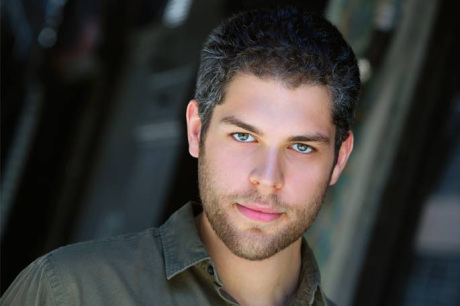 |
| photo: Arthur Cohen |
Gavriel Savit is not only an author, he is a New York actor, fresh off of a Broadway production of Amazing Grace. Anna and the Swallow Man, his debut novel, is set in World War II Poland. As Savit says, his book, if it's "about" anything, is about "living in the space of not knowing." It's also about a girl named Anna Lania, whose father, a linguistics professor, is taken away by Germans when she is seven years old, leaving her on her own in Kraków. A tall, mysterious--possibly even magical--gentleman she comes to call the Swallow Man takes her under his wing and together, for years, they traipse across war-ravaged Poland. From a Brooklyn rooftop at sunset, Savit talks to Shelf Awareness about his love of theater, Stephen Sondheim, the unreliable nature of memory and the existence of Peter Pan.
You're an actor in New York, and a busy one--even debuting on Broadway this year in Amazing Grace. What first attracted you to the theater?
The first time I remember being aware of the theater was when I went with my father up to Stratford, Ontario--there's a wonderful theater festival there. I grew up in Michigan, so Stratford was only a few hours' drive. My mother was out of town that weekend, so it was just my father and me. We saw West Side Story, The Tempest and A Midsummer Night's Dream. We were having such a great time that we stayed an extra afternoon.
Funnily enough, I first started thinking of acting professionally because of a book. I remember specifically, I was in high school, sitting and reading Kenneth Branagh's autobiography Beginning [W.W. Norton]. I was thinking, "Wow, this acting professionally thing seems pretty neat! Maybe I could do that!" And, as a typical teenager, I just sort of put the pedal to metal.
Is there a dream role you've always wanted to play?
Oh, there are so many. Sweeney Todd is obviously very high on the list. Sunday in the Park with George, playing the part of George. Basically I could just recite all the musicals of Stephen Sondheim, the living treasure! That's the wonder of theater. Every conceivable kind of twisted, messed-up, interesting, enlightened, beautiful human being is represented in the canon. It's fun to be able to skip around.

So how did Anna and the Swallow Man come into the picture?
The first idea I had was this image of an old European forest... and a small village in the middle of it. I was thinking about a tall man in a three-piece suit walking into this village in the middle of a rainstorm, and he was completely dry and he had no umbrella. And I was thinking of what a weirdly, perhaps titillatingly, perhaps disturbingly magical kind of presence he would be and how it would be more likely that a child would recognize that kind of subtle magic. Could that be achieved by a metaphysical magic or through more of a carefully constructed trickery? Or might those two things be complementary? That was the seed spark of the whole thing.
It had sat in my brain for a year or two, when I started thinking about putting together a one-man show that would explore questions of how reliable memory is and how we tell ourselves stories. It was going to be about an individual who had discovered an old, unpublished manuscript, a Holocaust memoir that had little hints of magic around the corners. The first thing I had to do to create this performance piece was write this memoir. So I did. And there's shockingly little difference between that and the book you see now. When I came back to look at it, I thought, hey, this is pretty good on its own. I brushed it off, and that's how we got Anna and the Swallow Man.
Interesting. So you didn't necessarily write it with a young audience in mind.
No, I didn't write it with any audience in mind. It's its own story, unselfconscious.
It seems like you have a lot of respect for children--their complexity and capacity and intuition. You philosophize a fair amount about the difference between adults and children, too. Where does that perspective come from?
It primarily comes from watching my nieces and nephews. I value a child's mindset. It's pretty undeniably great. I think it's more often an adult mindset that shuts off possibility. There's something really beautiful about the open, accepting, explorative, questioning mode of childlike thought.
There's one story that translates the whole thing very well. My niece Bella asked her father, "Daddy, can Peter Pan really fly?" My brother-in-law is a scientist, by profession and by temperament, and his response was, "No, he can't." And that's really not true! So far as there is a Peter Pan, part of Peter Pan's identity is that he can fly. You could question whether Peter Pan really exists, and I would argue that as well, because Peter Pan as a character exists in the popular psyche as much as, say, Barack Obama does. So I reject refutations of the existence of Peter Pan.
The Swallow Man tells Anna that the world is a dangerous place, and he does not reassure her that she will be safe.
When you are a tiny body in a gigantic world you know very implicitly that everything is threatening. The Swallow Man knows what kind of lie to tell and when, and it wouldn't have served anyone to tell her that particular lie.
Whenever something really tragic occurs in the public sphere, people respond that it is "senseless" or "inhuman." The fact is, human beings are dangerous animals sometimes. And the history of human warfare is endemic in the history of humanity.
I love the fable-like quality of the book. Part of that seems to come from the careful structure of it, such as when you write, "This was the first of three times that Anna heard the Swallow Man laugh." Did it feel fable-like to you?
Yes, it's an aesthetic that really appeals to me. I like it when narrators in fiction have a personality.
Erin Clarke, executive editor at Knopf, says your book sits at the intersection of magic realism and fairy tale. Do you like that assessment?
I completely agree with it. If I can manage to toe that line in all of my writing, I will be very happy.
Anna and the Swallow Man are both from the "rare tribe" that speaks multiple languages. It's the key to their survival as they navigate wartime borders. Are you in that rare tribe of polyglots?
I was privileged to learn Hebrew at the Hebrew Day School of Ann Arbor when I was growing up. I think languages enrich my understanding of my own brain and other people's brains. I think it's a key to the way we live our lives, using different words for different concepts. One of my favorite foreign words is Waldeinsamkeit, which is a German word for "the feeling of being alone in the forest."
What?!
Right? I mean there just needs to be that word.
Did you have an unusual upbringing? I don't necessarily mean wandering the meadows of Poland like Anna does.
Ann Arbor was a wonderful university town to grow up in. There was always an unlimited trove of potential knowledge nearby, which encouraged my curiosity. My father is a professor of theoretical physics at the University of Michigan, my mother teaches cello lessons out of her sunroom. I grew up in a Modern Orthodox Jewish community. I played the violin when I was very young. It was certainly a priority of my parents to expose me and my siblings to all the intellectual and cultural pursuits the world had to offer. I am grateful. It's the kind of childhood I hope I can offer to my own children someday.
How would you describe the Swallow Man to people who haven't read the book?
He's very tall, he has long fingers, he doesn't talk very much unless he wants to. Beyond that, I think there's a degree to which the Swallow Man is, in and of himself, sort of a magic trick. Which is to say there are certainly true, boots-on-the-ground details about him. He has a name, he was born in a place. But his existence in the world of the story is predicated on not knowing exactly how he works. That's the thing about a magic trick, right? As soon as you see the guy is just holding the coin in his hand the whole time, well, that's not so impressive, that's not so interesting. There are certain things about the Swallow Man that it's better not to know. --Karin Snelson
Interior images by Laura Carlin from Anna and the Swallow Man.
Anna and the Swallow Man is the First In Line December Monthly Pick. First In Line, presented by Random House, is an exclusive YA experience that lets members be the first to read the last line of the next big thing and features bonus book and author content, giveaways, videos and more. Click here to secure your place in line and access Gavriel Savit's Members Only Content, including a q&a with James Dashner, author of the Maze Runner and the Mortality Doctrine series; photos from his day (and night!) job as a Broadway actor; his favorite taco recipes; and the playlist he listened to while writing Anna and the Swallow Man.











 In addition to The Good War, Terkel collected oral histories of the Great Depression in Hard Times (1970) and, in 1974, Pantheon published Working: People Talk About What They Do All Day and How They Feel About What They Do. In nine books organized by theme, Terkel interviewd everyday Americans from all rungs of the socioeconomic ladder about how they experience employment. The first chapter, subtitled "Working the Land," contains accounts from farmers and miners, among others. The rest of the book ranges through professions from grave digger to supermarket clerk to business executive, creating a nuanced view of working life as often difficult but potentially meaningful.
In addition to The Good War, Terkel collected oral histories of the Great Depression in Hard Times (1970) and, in 1974, Pantheon published Working: People Talk About What They Do All Day and How They Feel About What They Do. In nine books organized by theme, Terkel interviewd everyday Americans from all rungs of the socioeconomic ladder about how they experience employment. The first chapter, subtitled "Working the Land," contains accounts from farmers and miners, among others. The rest of the book ranges through professions from grave digger to supermarket clerk to business executive, creating a nuanced view of working life as often difficult but potentially meaningful.










